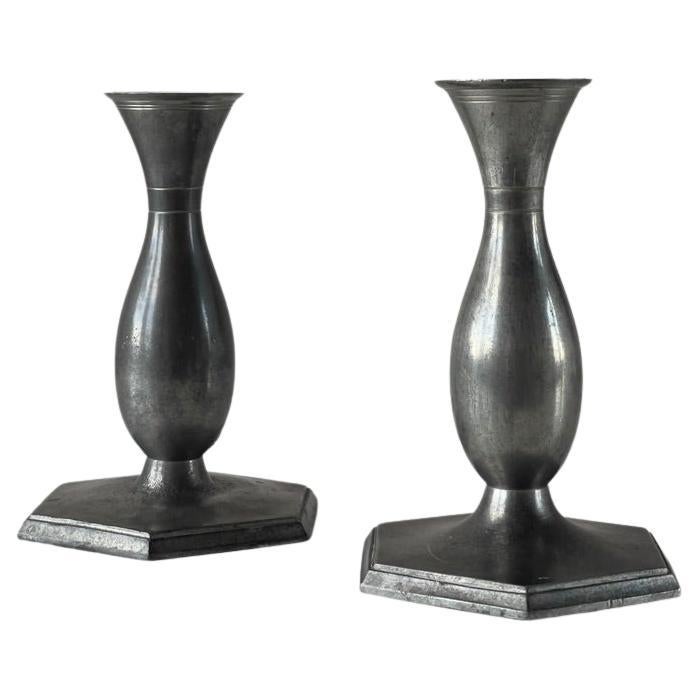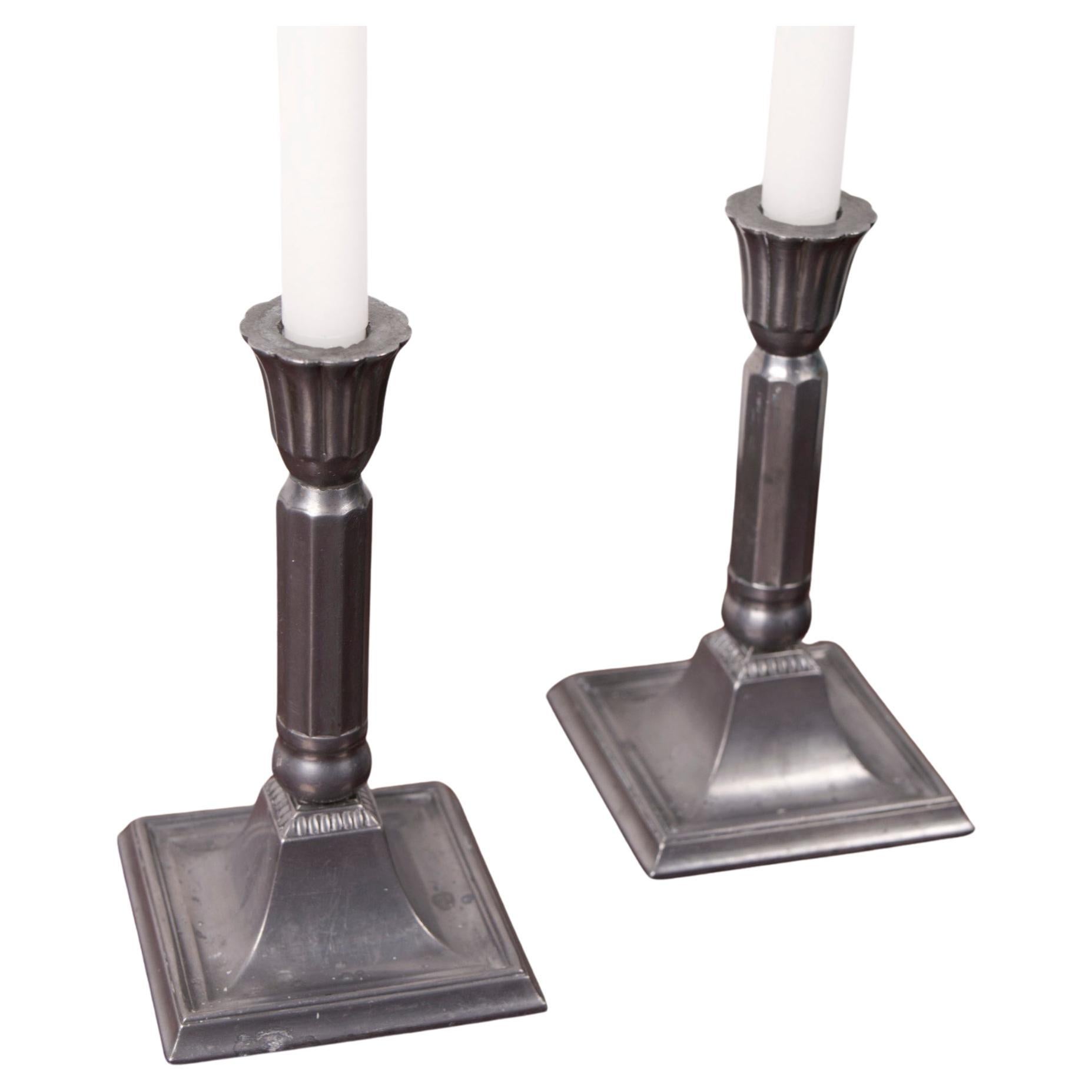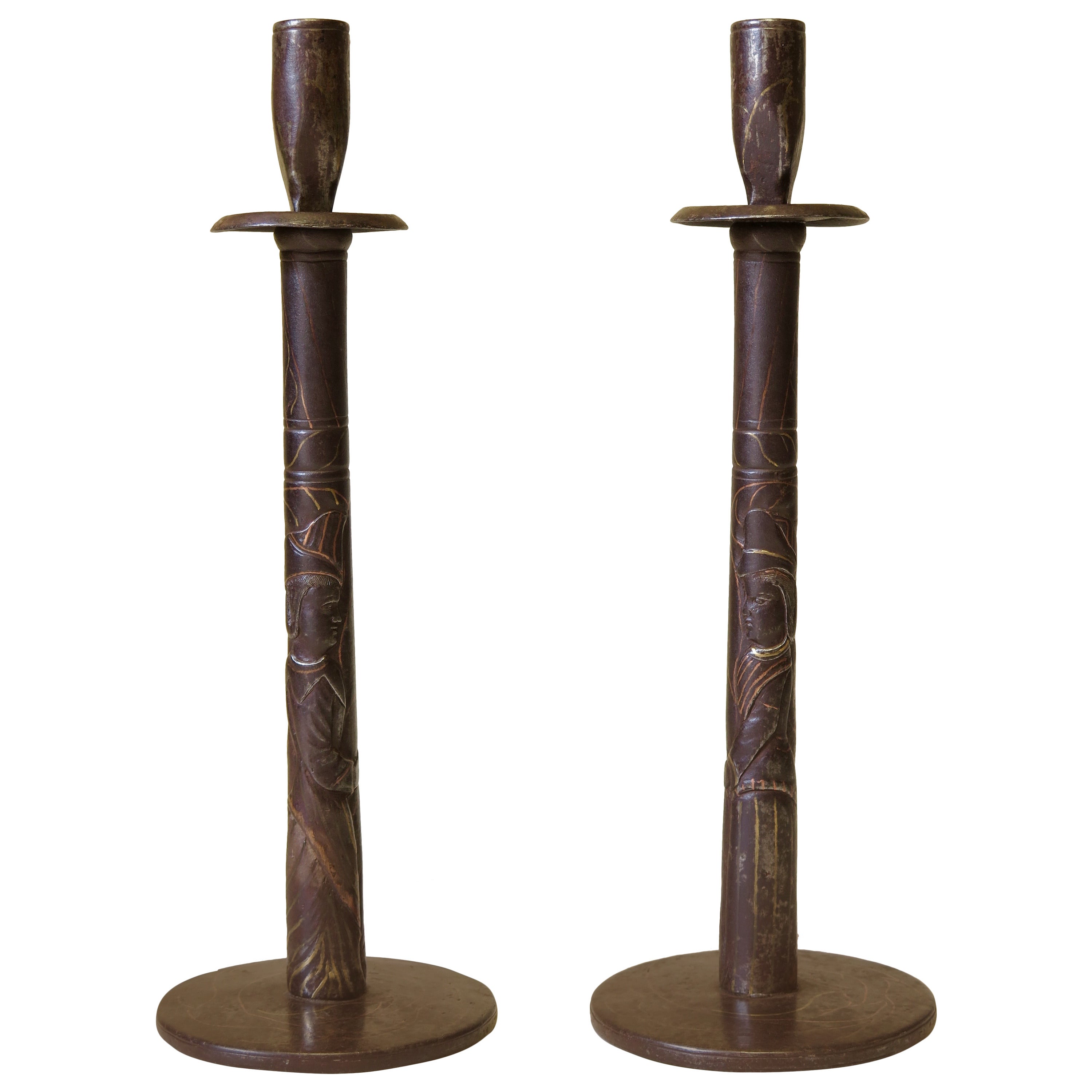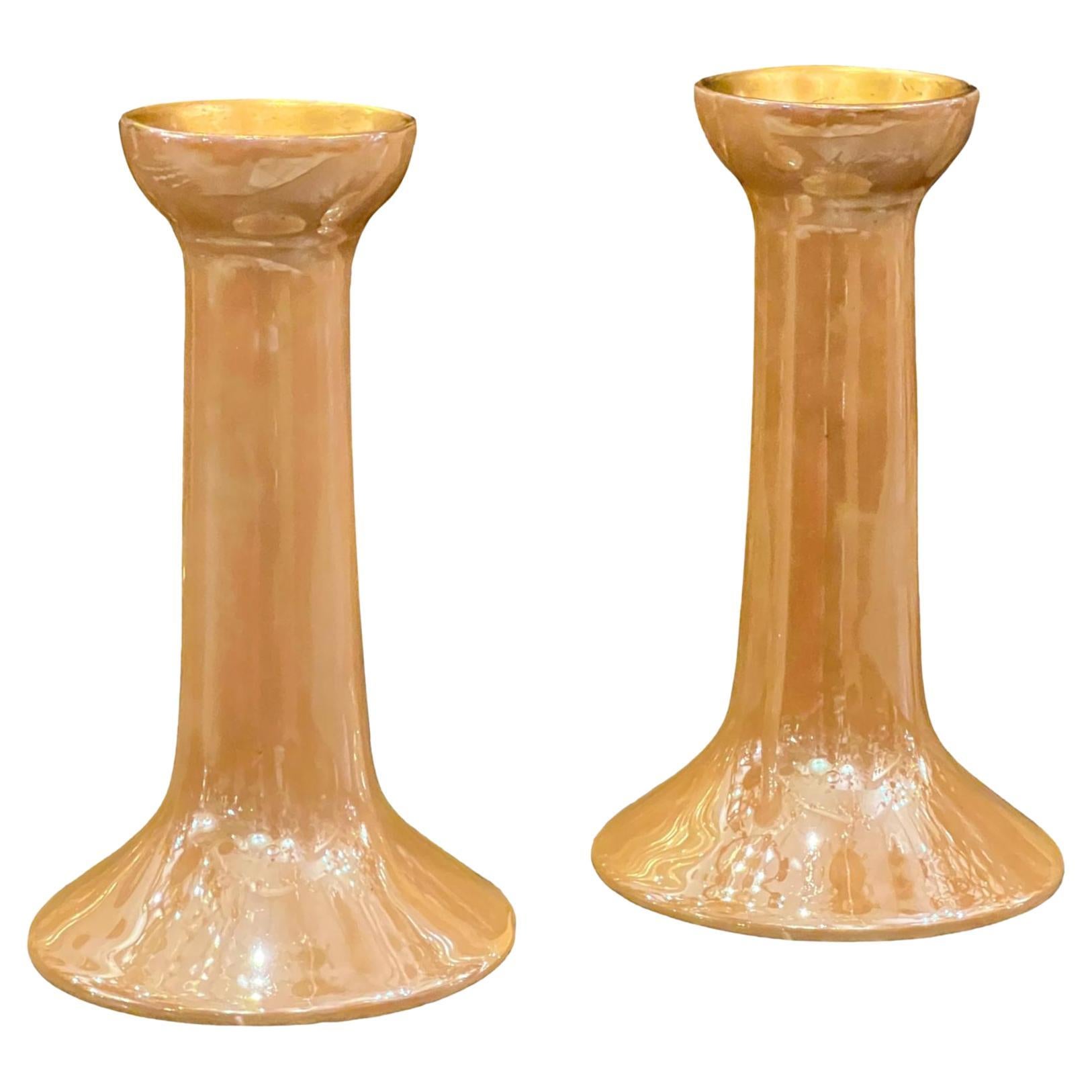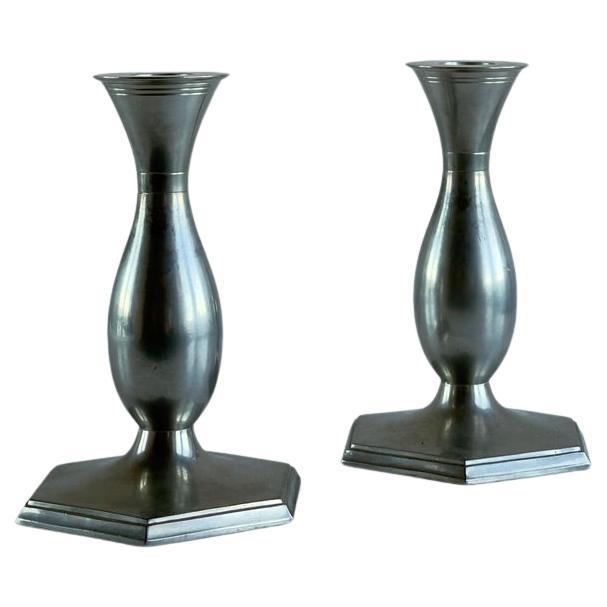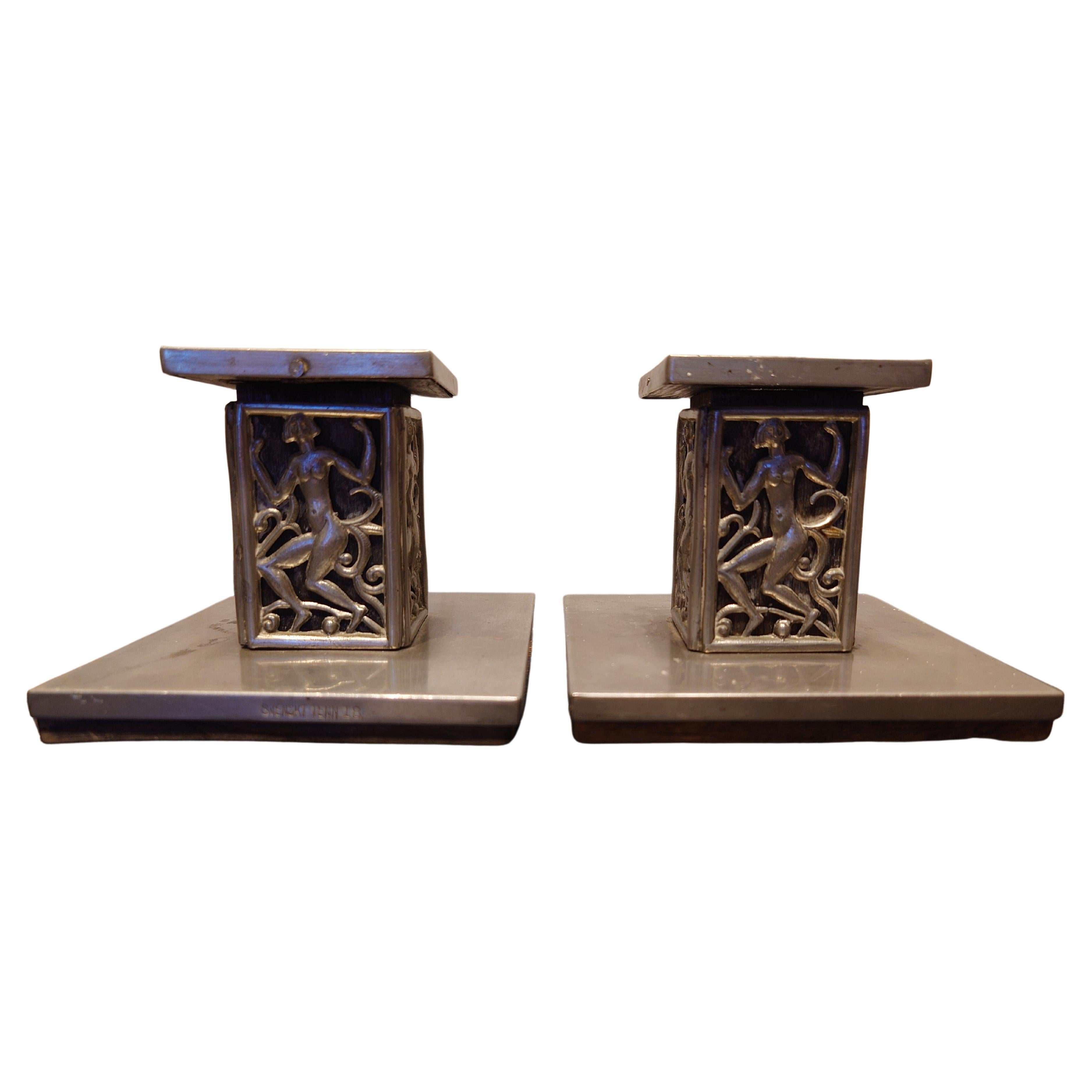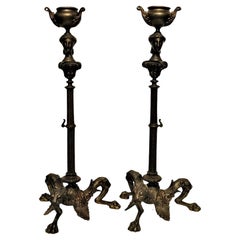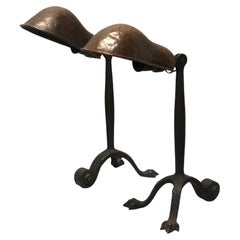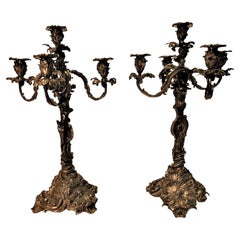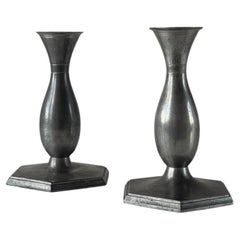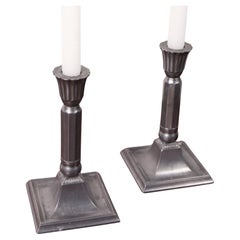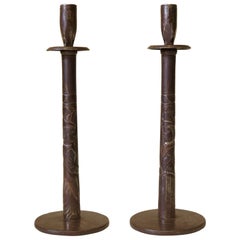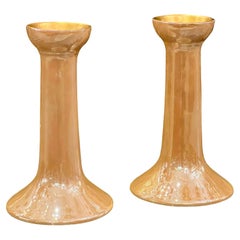Items Similar to A Pair of Art Deco Ceramic Candle Holders by Roockwood Pottery, ca. 1920
Want more images or videos?
Request additional images or videos from the seller
1 of 11
A Pair of Art Deco Ceramic Candle Holders by Roockwood Pottery, ca. 1920
$2,800
£2,116.26
€2,439.07
CA$3,950.80
A$4,354.06
CHF 2,279.49
MX$53,481.58
NOK 28,642.33
SEK 26,806.94
DKK 18,211.10
About the Item
MARKINGS
Each candle holder is fully marked on the bottom, including date XX (ca. 1920) and model number (2304).
ROOCKWOOD POTTERY
Roockwood is the synonym of the American Art Pottery. Founded on Thanksgiving Day in 1880 by Maria Longworth Storer, Rookwood made history – the first large manufacturing enterprise founded and owned by a woman in the United States and launching the art pottery movement in America. Within a decade, Rookwood pottery gained international acclaim, rivaling European and Asian firms that had been in existence for hundreds or thousands of years.
Maria Longworth Nicholas, was the daughter of a wealthy art collector, she was inspired by Japanese pottery. When she discussed her desire to create fine pottery with her father, he provided the means and environment that allowed her to pursue her creative passions. And although it may have started as a hobby, the talented Maria quickly managed to establish Rookwood pottery as a quality producer of fine ceramic art potter.
She setup the Rookwood company, hired artists like Japanese artist Kataro Shirayamadani who came to work for the company in 1887, and talented art students and encouraged them to use their creativity to experiment and create unique pottery pieces. Almost every piece designed by these artists sold for hundreds of dollars, and today they are regarded as highly collectible. A Rookwood piece by Japanese artist Kataro Shirayamadani sold for $198,000 in 1991. He was a Rookwood artist from 1887 until 1948.
The Rookwood airbrush, called the mouth atomizer, was developed by Rookwood to apply glazes in an innovative way. The technique helped the company develop its own individual look. The atomizer helped add the beautiful layers of color Rookwood is known for, and the technique is still used at the Rookwood pottery today.
More well-known pottery manufacturers and recognized artists doubted this female led company would have what it takes to succeed, but much to their surprise Rookwood turned out to be one of the best. By combining extraordinary attention to detail and innovative design Maria Longworth Nicholas made Rookwood the standard for ceramic pottery manufacturers to aim for.
Today antique and vintage Rookwood Pottery can easily command high prices and individual piece can rank alongside the best pottery Europe can produce. Rookwood has tradition, design innovation and a long history of 130 years behind it. This relatively long history, in American terms, and being an original American art work can add substantial value to antique Rookwood pottery pieces. But the company hasn't always had a smooth ride.
In the 1920s the company prospered and sales peaked as Rookwood joined Tiffany as one of the most sought after products to grace well-heeled households. By 1941, demand had slumped and the Rookwood company filed for bankruptcy, only just managing to stay in business when it was bought out. In 1982, Arthur Townley an avid Rookwood collector bought the company to save it and its assets being shipped overseas. Rookwood was mothballed as Townley waited for a buyer who could re-build the brand. In 2004, Arthur Townley was persuaded to sell to a group of investors who shared his passion for Rookwood Pottery. They quickly pulled together a team of artists and designers to establish the Rookwood brand as one of the best in the World. In 2011, Martin and Marilyn Wade took control of Rookwood Pottery. Reinvigorating the brand and returning it to its tradition of excellence and top quality innovative design.
- Creator:Rookwood Pottery Co. (Maker)
- Dimensions:Height: 11.25 in (28.58 cm)Width: 3.75 in (9.53 cm)Depth: 4.75 in (12.07 cm)
- Style:Art Deco (Of the Period)
- Materials and Techniques:Ceramic,Glazed
- Place of Origin:
- Period:
- Date of Manufacture:circa 1920
- Condition:Wear consistent with age and use. We make our best effort to provide a fair and descriptive condition report. Please examine photos attentively, as they are an integral part of the description. Send us a message to request more details or discuss price.
- Seller Location:New York, NY
- Reference Number:1stDibs: LU2819331888202
About the Seller
5.0
Gold Seller
Premium sellers maintaining a 4.3+ rating and 24-hour response times
Established in 1993
1stDibs seller since 2017
85 sales on 1stDibs
Typical response time: 8 hours
- ShippingRetrieving quote...Shipping from: New York, NY
- Return Policy
Authenticity Guarantee
In the unlikely event there’s an issue with an item’s authenticity, contact us within 1 year for a full refund. DetailsMoney-Back Guarantee
If your item is not as described, is damaged in transit, or does not arrive, contact us within 7 days for a full refund. Details24-Hour Cancellation
You have a 24-hour grace period in which to reconsider your purchase, with no questions asked.Vetted Professional Sellers
Our world-class sellers must adhere to strict standards for service and quality, maintaining the integrity of our listings.Price-Match Guarantee
If you find that a seller listed the same item for a lower price elsewhere, we’ll match it.Trusted Global Delivery
Our best-in-class carrier network provides specialized shipping options worldwide, including custom delivery.More From This Seller
View AllA Pair of Bronze Neoclassical Grand Tour Candelabras, Late 19th Century
Located in New York, NY
Grand Tour
Pair of Bronze Candelabras
Late 19th Century
DIMENSIONS
Height: 10.33 inches
Width: 4.75 inches
Depth: 4.75 inches
ABOUT
We present to your attention a pair of stunning...
Category
Antique 1890s English Grand Tour Candelabras
Materials
Bronze
American Arts & Crafts Pair of Patinated Bronze Table Lamps, circa 1910
Located in New York, NY
American Arts & Crafts
A Pair of Table Lamps
Patinated Bronze
Circa 1910
DIMENSIONS
Height: 15 inches
Width: 6 inches
Depth: 12 ...
Category
Vintage 1910s American Arts and Crafts Table Lamps
Materials
Bronze
Pair of Mid-Century Modernist Anodized Brass Lotus Candlesticks, USA, 1950s
Located in New York, NY
A duo of anodized brass candlesticks, each featuring a round base, stem and a lotus flower that contains a regular size candle. Manufactured in the USA during the 1960s.
The cand...
Category
Mid-20th Century American Mid-Century Modern Candlesticks
Materials
Brass
Pair of American Rococo Revival Patinated Bronze Candelabras, Ca. 1825
Located in New York, NY
Bronze, dark-brown patina, unmarked.
Measures: Height: 23”
Width: 14”
The notion of an “American Rococo” seems a contradiction in terms. The very word rococo is as French as Camembert. It connotes a style that reigned along with Louis XV in the aristocratic decadence of the 18th Century. It was garlanded, nonchalant, associated with erotic marshmallow nudes by Francois Boucher and foppish courtiers costumed as shepherds pretending they understood Jean-Jacques Rousseau when all they really wanted was romantic dalliance in the formal gardens of Versailles. In the history of painting it produced but one great artist, Antoine Watteau.
By contrast, Americans of the period are remembered as the flinty inheritors of New England Puritans, full of rectitude and having not a moment for furbelow or frippery. Such few painters as were around included hard-nosed realists like John Singleton Copley and Charles Willson Peale.
Well, as it turns out, life once again acts according to the principle of paradox. There was an American rococo. It came to us indirectly via England disguised under the name Chippendale. Now for the first time the style receives comprehensive survey in the exhibition “American Rococo, 1750-1775: Elegance in Ornament.” Jointly organized by New York’s Metropolitan Museum and the Los Angeles County Museum of Art, it opens here Sundaywith a spread of some 170 works of decorative art and a conscientious catalogue with essays by Met and LACMA curators Morrison H. Heckscher and Leslie Greene Bowman.
There are at least two ways of looking at the decorative arts. Connoisseurs appreciate their design and craftsmanship. Those of sociological bent examine objects of material culture for their revelations of history and the temper of the times. Actually neither view is complete without the other.
Stylistically the rococo reveals a longing for intimacy in its small scale and an urge to organic nature in its love of stylized vines, tendrils, tiny flowers and seashells. If it were a new manner being promoted by Madison Avenue today it would probably be called “Baroque Lite.” There is an ease about the style that makes it airy, but it has an underlying formality that bespeaks lives of gentrified cultivation rather than beer-bellied sloth. It’s fascinating to examine the flintlock firearms on view and find these weapons of death shaped and decorated with the most exquisite care by wood carvers and metal engravers.
All of this is completely consistent with the main currents of 18th-Century European thought. In France, Rousseau sang the virtues of nature and the noble savage like a present-day ecologist. In England, John Locke...
Category
Antique 1820s American Rococo Revival Candelabras
Materials
Bronze
Alfonso Canciani, Viennese Secession Orientalist Bronze Vase, c. 1910
By Alfonso Canciani
Located in New York, NY
Alfonso Canciani (Italian-Austrian, 1863-1955) was a famous Italian-Austrian sculptor of the period of accession to the Viennese Secession. Son of a stonemason, after a realist period he managed to establish himself as a leading sculptor of the Viennese Secession. In fact, he worked in Vienna, where he had enrolled in 1886 at the Academy of Fine Arts, then at the Higher School of Sculpture and finally at the Special School, where he obtained the Rome prize for the sketch for Dante's Monument.
He developed a notable business obtaining important prizes and numerous commissions. First among the sculptors of the Viennese capital, he was invited to join the Association of the Viennese Secession, of which Klimt was magna pars, after the exhibition of Dante's group in 1900 at the Secession exhibition, and obtained the most important Austrian artistic prize, the Kunstlerlpreis.
This same work, presented in 1910 in Berlin, at the Great Art Exhibition, also received an important recognition here. He obtained the Rome prize in 1896, exhibited successfully in Munich and in 1899 at the III International Art Exhibition in Venice.
In that period he made some statues of saints for the cathedral of Santo Stefano in Vienna, the monument to Wagner, the bust of Nietzsche for the University, the scepter and the gold chain of the University Rector, figures of Italian poets ( Petrarch, Boccaccio, Tasso, Ariosto).
He submitted a sketch for the official monument to Empress Elizabeth, which was then built in Austrisn Gföhl and Pula. At the time of his accession to the Secession, he dedicated himself to decorating the facade of the Artaria house in Vienna in collaboration with the architect Max Fabiani.
He later abandoned the symbolist decorativism of the Jugendstil for a more concentrated and vigorous style, approaching the Belgian sculptor Constantin Meunier for the theme of work, and preferring to exhibit at the Künstlerhaus.
In Vienna, he was generous with advice and help with the Italians and in particular with his fellow citizens (such as the Brazzanese Luigi Visintin, then a university student).
After the First World War, he returned to Italy and lived in Friuli, penalized by the fact that the Habsburg Empire had by now disappeared. Instead of large-scale public monuments, he then devoted himself to engraving medals (e.g. for Benedict XV and for the Italian mission in Vienna in 1919) and to designing funeral monuments (examples in Mali Lošinj and Trieste) and portrait busts (of Generals Carlo Caneva and Antonio Baldissera in Udine, sculptures of the War Memorial of Corno di Rosazzo). After all, he had already executed the Bab grave monument in the Döblinger cemetery in Vienna in 1909.
He taught in Trieste from 1920 until 1935, at the local school of industrial art, where he had Marcello Mascherini...
Category
Vintage 1910s Austrian Jugendstil Vases
Materials
Bronze
Pair of Japanese Patinated Bronze Candelabras, Meiji Period, ca. 1900
Located in New York, NY
This most unusual pair of original 18th century Japanese patinated bronze candelabras, uniquely designed as branches of mountain flowers entangled by a dragon, are mounted on the con...
Category
Antique Late 19th Century Japanese Japonisme Candelabras
Materials
Bronze
You May Also Like
Pair of danish art deco metal candlesticks by sculptor Just Andersen. 1920s
By Just Andersen
Located in København K, 84
These rare and elegantly shaped 1920s Art Deco candlesticks are the work of renowned Danish sculptor and metalworker Just Andersen. Known for his innovative use of materials, Anderse...
Category
Vintage 1920s Danish Art Deco Candlesticks
Materials
Pewter
A Pair of Art Deco candle sticks by Just Andersen, model D54, Denmark, 1930s
By Just Andersen
Located in Balen, BE
Pair of Art Deco Candlesticks by Just Andersen, Model D54 – Denmark, 1930s
This refined pair of Art Deco candlesticks, model D54, was designed by renowned Danish designer Just Ander...
Category
Vintage 1930s Danish Art Deco Candlesticks
Materials
Metal
Pair of Art Deco "M. & Mme." Chiselled Iron Candlesticks, France circa 1930s
Located in Isle Sur La Sorgue, Vaucluse
Wonderful and very unusual pair of iron candle holders with a gunmetal finish, and decorated with inlays of red copper and yellow brass, in flowing, leaf like motifs. The stems are d...
Category
Early 20th Century French Art Deco Candlesticks
Pair of Art Deco Porcelain Candlesticks
Located in New York, NY
A pair of Art Deco circa 192o'a French luster-glazed porcelain candlesticks.
Measurements:
Height of body: 6.5"
Diameter of base: 4".
Category
Vintage 1920s French Candlesticks
Materials
Porcelain
$800 / set
Pair of danish art deco metal candlesticks by sculptor Just Andersen. 1920s
By Just Andersen
Located in København K, 84
These rare and elegantly shaped 1920s Art Deco candlesticks are the work of renowned Danish sculptor and metalworker Just Andersen. Known for his innovative use of materials, Anderse...
Category
Vintage 1920s Danish Art Deco Candlesticks
Materials
Pewter
Pewter candlesticks made by David Wretling. Art deco 30s
Located in Boden, SE
Fantastically decorative Art Deco candlesticks designed by David Wretling 30s.
stamped Swedish pewter
I8=1935
Minor wear. Scratches. Brands. Dents,
Category
Vintage 1930s Swedish Art Deco Candlesticks
Materials
Pewter
More Ways To Browse
International Pottery
Antique Japanese Pottery
Art Deco Pottery Glazed
Antique Pottery Companies
Pottery Rookwood
Antique Rookwood
Antique Rookwood Pottery
Hobbies Antique Furniture
Antique Atomizers
Kataro Shirayamadani
Bronze Art Nouveau Candle
Jens Quistgaard Candleholder
Used Votive Candle Holders
Vintage Votive Holders
Art Deco Bronze Candlesticks
Silver Plated Candlesticks French
Stamp Holder
Antique Chinese Candle Holders
